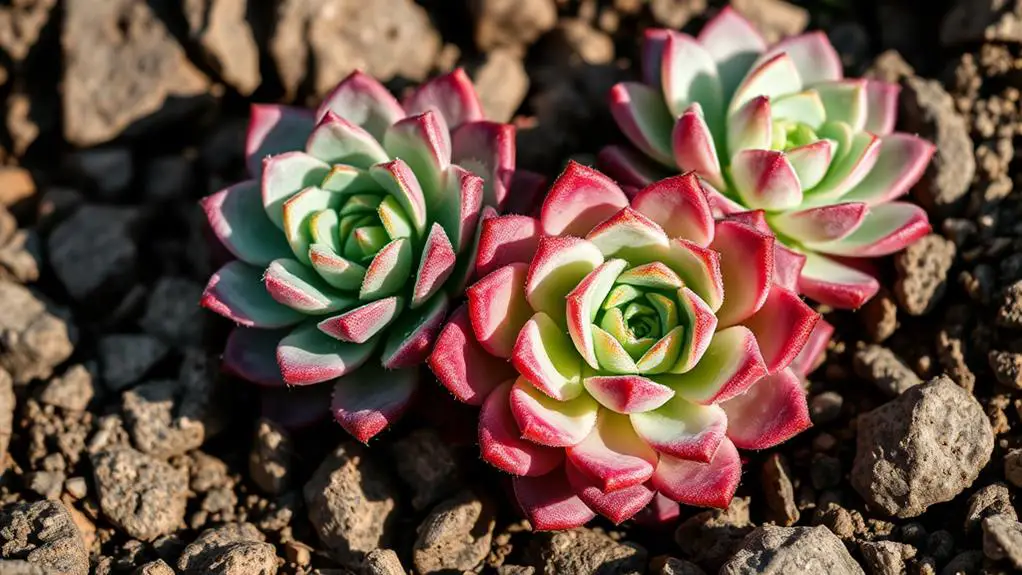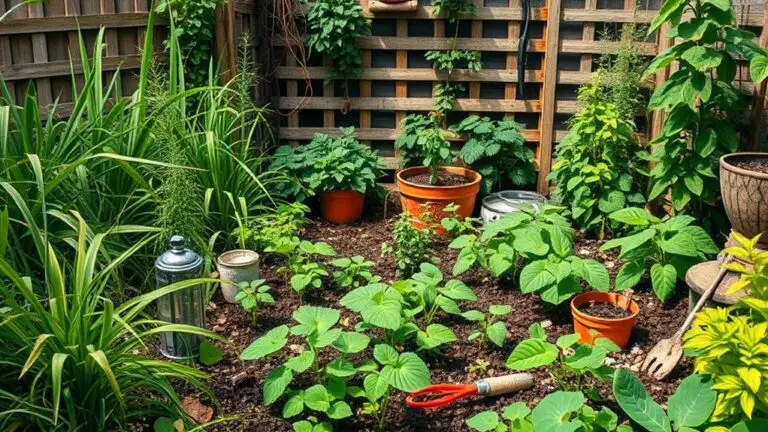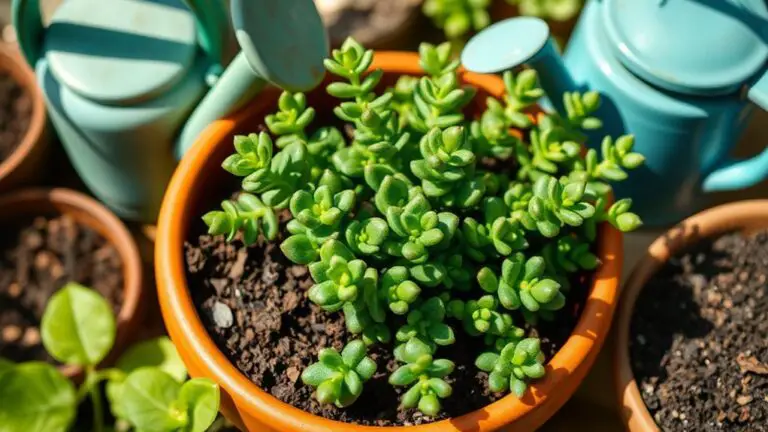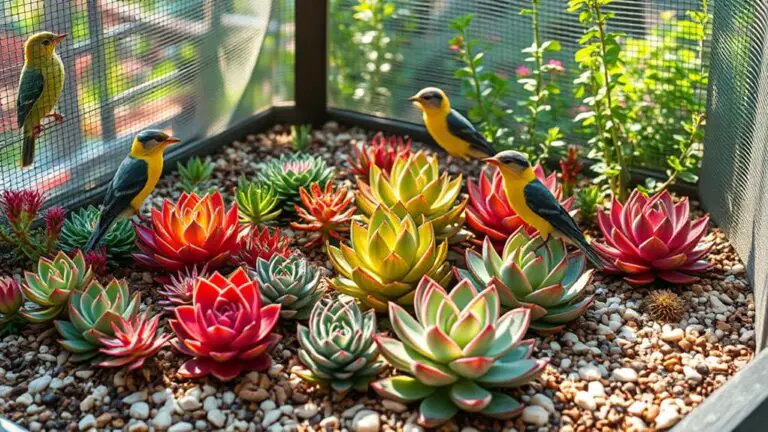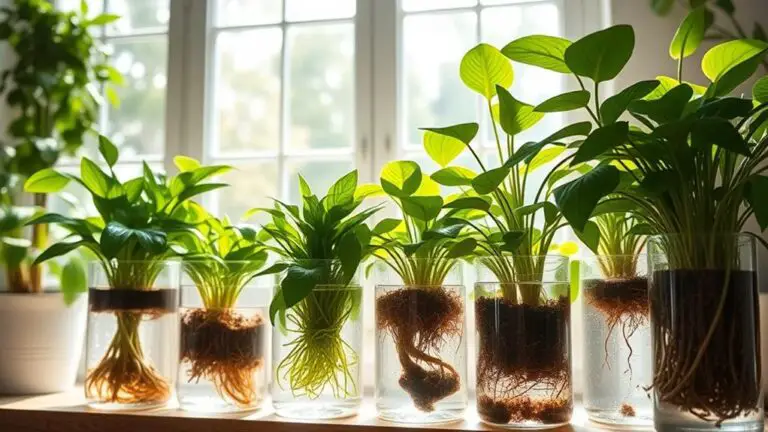Growing and Caring for Sempervivum Hens and Chicks: The Ultimate Cold-Hardy Succulents
When you decide to grow Sempervivum Hens and Chicks, you're choosing a resilient and visually appealing addition to your garden. These cold-hardy succulents thrive in various climates and require minimal upkeep, making them perfect for both novice and experienced gardeners. Their striking rosettes come in a range of colors, adding a unique touch to your landscape. But what really sets them apart is their ability to produce offsets, or "chicks," ensuring a continuous spread. Curious about how to maximize their potential and keep them thriving year-round? Let's explore the essential steps and tips that can help you achieve just that.
Basics of Hens and Chicks

Discovering the basics of hens and chicks, scientifically known as Sempervivum spp., reveals why these hardy succulents are a favorite among gardeners. These resilient plants thrive in USDA zones 4-10 and can even be grown indoors as houseplants.
Hens and chicks are perfect for beginners and experienced gardeners alike because they're low-maintenance and easy to care for.
Hens and chicks feature symmetrical rosettes of fleshy leaves that come in a variety of beautiful colors. These rosettes, or "hens," produce smaller offsets called "chicks" that can be easily propagated.
To keep your succulents looking their best, plant them in well-draining soil. Sandy soil with a neutral pH of 6.5-7.5 works wonders for these drought-tolerant plants.
For vibrant foliage, guarantee your hens and chicks get at least 6 hours of full sun daily. In hotter climates, some afternoon shade will help them thrive.
Watering is minimal—every 10-14 days during dry spells is sufficient. These plants are great for rock gardens, ground cover, and areas with poor soil conditions.
With their hardiness and beauty, hens and chicks are a delightful addition to any garden.
Planting and Propagation
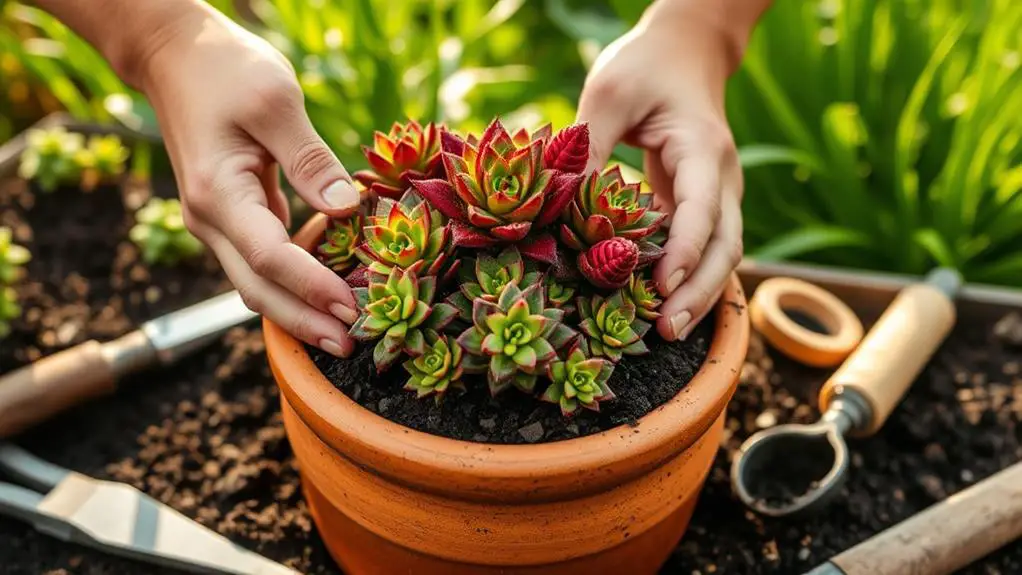
Now that you understand the basics of hens and chicks, let's explore the best practices for planting and propagating these delightful succulents.
Sempervivum can be planted anytime except during freezing temperatures or extreme heat. Choose a full sun location with well-draining soil to guarantee ideal growth. When spacing your plants, aim for 6 to 12 inches apart to give them room to thrive.
Propagation is simple with offsets, also known as chicks. You can separate these from the mother plant anytime. Make sure the offsets have roots intact to promote successful growth. Once separated, plant them in well-draining soil.
If you prefer starting from seeds, sow them in spring or fall. Lightly moisten the soil and keep them in a bright location. Germination usually occurs within three weeks.
When transplanting seedlings, wait until they're about 1 inch across. Gradually acclimate them to outdoor conditions before planting them in their permanent spot.
Using fine gravel mulch can help retain moisture while preventing rot. By following these steps, you'll guarantee your Sempervivum hens and chicks are well-established and ready to flourish in your garden.
Care and Maintenance

To keep your Sempervivum healthy, make sure it gets watered every 10-14 days during dry spells and planted in well-drained soil.
Regularly clean up by removing dead or damaged leaves to help the plant breathe and grow.
Watch out for pests like mealybugs and aphids, but don't worry too much—these plants are usually quite tough.
Watering and Soil Needs
Sempervivum hens and chicks thrive in well-draining, sandy, or gravelly soil with a neutral pH of 6.5 to 7.5, which prevents root rot and promotes healthy growth.
When it comes to watering, less is more. These succulents need minimal watering, so let the soil dry out completely between waterings. Typically, you should water every 10-14 days during dry spells. Deep soaking is essential—water the plants thoroughly, ensuring the moisture reaches the roots but doesn't create standing water.
To monitor moisture levels, use your finger or a soil moisture meter to check if the soil is dry before watering again. Overwatering can lead to serious problems, including root rot, which you definitely want to avoid.
Ideal soil enhances drainage, so if your soil is heavy, mix in some coarse sand or pumice. This helps improve drainage, creating the best conditions for your Sempervivum to flourish.
Pruning and Clean-Up
Pruning and cleaning up your Sempervivum hens and chicks is essential for their well-being and aesthetic appeal. Regular pruning helps maintain healthy growth and an attractive appearance. Start by removing any brown, yellow, or damaged leaves. This not only improves the look of your plants but also prevents pests and diseases from taking hold.
After your hens and chicks flower, allow the dead flower stalks to remain until they dry out. This approach minimizes disturbance to nearby offsets and supports natural decomposition. Monitor your plants for overcrowding and remove excess chicks to prevent competition for nutrients and space.
Cleaning up debris around your Sempervivum is vital, especially during winter. This reduces moisture accumulation, warding off pests and diseases. Be sure to discard any removed dead leaves or plant material away from your garden to minimize disease spread.
Here's a summary to visualize these steps:
| Task | Purpose | Benefit |
|---|---|---|
| Remove dead leaves | Prevent pests and diseases | Promotes healthy growth |
| Leave flower stalks | Support natural decomposition | Avoids disturbing offsets |
| Clean up debris | Reduce moisture accumulation | Prevents pests and diseases |
Pest and Disease Management
Managing pests and diseases in your Sempervivum hens and chicks is vital for maintaining their health and vigor. Although these plants are generally resistant to pests, you might encounter mealybugs and aphids, especially in humid or poorly-aerated environments.
To tackle mealybugs, simply dab them with a cotton ball soaked in rubbing alcohol. For more severe infestations, consider using insecticides.
Root rot is a significant threat to your hens and chicks, often caused by too much moisture. To prevent this, verify your soil has adequate drainage. This helps keep the roots dry and healthy.
Fungal diseases, like powdery mildew, can also affect your plants. You'll recognize it as a white powder on the leaves. Regular monitoring is key to catching these issues early.
Maintaining good airflow around your Sempervivum is also important. Avoid overcrowding your plants, as this can lead to pest outbreaks and fungal diseases. Proper spacing guarantees better airflow, which keeps your plants healthier.
Design Applications
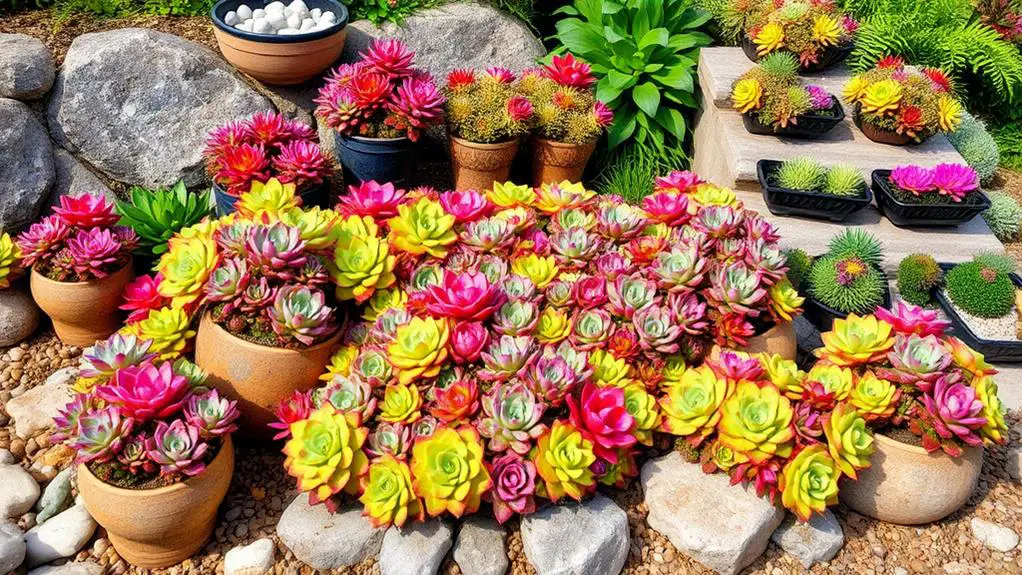
When it comes to design applications, hens and chicks offer unparalleled versatility and charm. These succulents are perfect for rock gardens, thriving in dry, sunny areas with minimal soil. They effortlessly fill crevices, adding visual interest to your landscape. Plus, you can use them to enhance the beauty of your garden with their unique shapes and textures.
Mass planting hens and chicks on slopes creates cascading effects. This not only adds depth and texture but also helps prevent soil erosion. They pair well with other drought-tolerant plants in containers, making easy-to-maintain, diverse arrangements. Imagine a pot bursting with different succulents, all requiring minimal care!
For a creative touch, try vertical gardens. Hens and chicks soften hard surfaces and create colorful mosaics with their various leaf colors and forms. They look stunning against walls or fences, providing eye-catching displays.
Additionally, you can use them in themed displays based on seasonal colors, enhancing your garden's aesthetics year-round.
Incorporating hens and chicks into your garden design allows you to enjoy a landscape full of texture, color, and resilience. These versatile succulents make it easy to create beautiful, low-maintenance gardens that thrive in various conditions.
Ground Cover Benefits
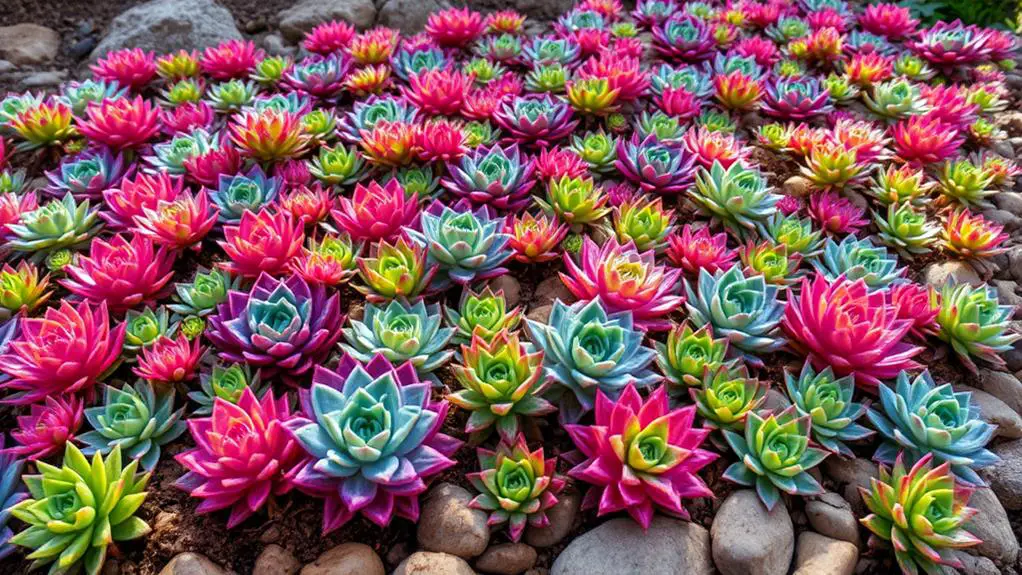
In addition to their design versatility, hens and chicks offer remarkable ground cover benefits. These cold-hardy succulents are fantastic for sunny spots, thriving even in drought conditions with minimal maintenance. Once established, they spread to form dense colonies, which effectively prevent soil erosion, especially on slopes or in rocky gardens.
You'll find that hens and chicks can handle a variety of soil types, making them a versatile choice for your landscape. They grow well in poor, rocky, and sandy soils where other plants might struggle.
Here are some key benefits of using hens and chicks as ground cover:
- Drought-resistant: These plants require very little water, making them perfect for low-water landscapes.
- Erosion control: Their dense growth helps stabilize soil, reducing erosion on slopes.
- Biodiversity: Hens and chicks attract pollinators, enhancing the biodiversity of your garden.
Furthermore, these plants can tolerate temperatures as low as -25°F, making them suitable for gardens in USDA zones 4-9.
You'll enjoy year-round visual interest and a lush aesthetic throughout the growing season. With hens and chicks, you're not just planting; you're investing in a resilient and beautiful ground cover solution.
Varieties and Displays
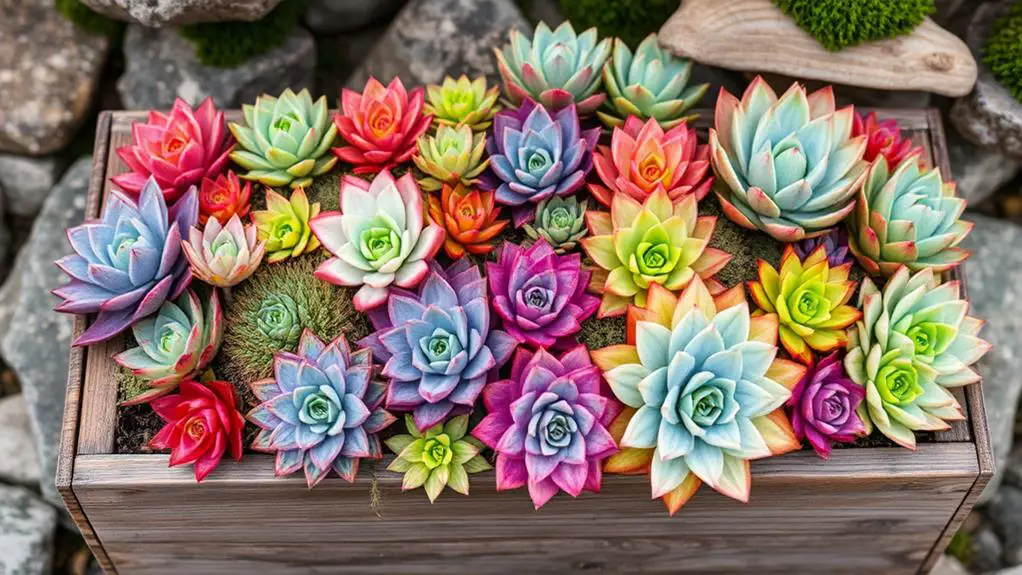
Let's talk about some amazing Sempervivum varieties and how you can show them off.
You'll find cultivars like Black Lotus with its deep red hues and Cebenese with its pale green leaves edged in mauve, offering a stunning mix of colors and textures.
For a striking display, try using these hens and chicks in living wreaths, vertical gardens, or even as cascading ground cover in rock gardens.
Notable Sempervivum Varieties
Discover the enchanting world of Sempervivum varieties that bring a dynamic splash of color and texture to any garden. These Hens and Chicks are perfect for garden displays, offering vibrant hues and unique shapes.
They're cold-hardy and their rosettes thrive in various conditions, guaranteeing your garden looks spectacular year-round.
Let's explore some notable Sempervivum varieties:
- Black Lotus: This variety features stunning year-round red coloration and dark maroon leaves in winter, making it a standout addition to any garden.
- Cebenese: Known for its pale green leaves edged with mauve, this variety thrives in zones 5-9 and adds a delicate touch to your garden.
- Greenii Houseleek: Showcasing blue-green foliage with maroon tips, it can grow 4-6 inches tall and is popular in zones 4-9.
For a more vibrant display, consider the Sunset variety, which produces striking green and burgundy foliage and reaches heights of 1-3 inches.
The Mark Weller cultivar is also impressive, as it changes color with temperature and prefers some shade during peak sunlight. Its rosettes can grow up to 5 inches tall, enhancing your garden's texture and depth.
Choosing the right Sempervivum varieties will assure your garden is always lively and inviting.
Seasonal Display Ideas
Transform your garden with enchanting seasonal displays using Sempervivum Hens and Chicks. These cold-hardy succulents offer a versatile way to enhance your landscape aesthetic and create visually appealing arrangements. For a unique touch, consider showcasing hens and chicks in living wreaths. Hang them on entryways or use them as centerpieces for special events to add greenery and color.
You can mix different Sempervivum varieties, like the vibrant Terracotta Baby and the striking Black Lotus, to keep your displays interesting throughout the year. Plant them in decorative containers with other drought-tolerant plants, and place them in your summer garden or on an outdoor patio for a stunning focal point.
To soften harsh lines of rock walls, plant hens and chicks in the cracks. Their cascading growth will naturally enhance the landscape aesthetic. You can also create themed seasonal displays, such as reds and greens for winter holidays or pastels for spring, to keep your garden lively year-round.
Here's a simple table to inspire your seasonal displays:
| Season | Sempervivum Varieties |
|---|---|
| Winter Holidays | Reds and greens |
| Spring | Pastel-colored varieties |
| Summer | Terracotta Baby, Black Lotus |
Use these ideas to transform your space with hens and chicks!
Color and Texture**
To complement your seasonal displays, understanding the vibrant color and intriguing texture of Sempervivum varieties is key. These hardy succulents offer a stunning array of colors and textures that can transform any garden.
You'll find varieties showcasing foliage in shades of green, burgundy, purple, and even vibrant orange and yellow. This dynamic color range guarantees your garden looks appealing all year round.
- "Black Lotus": This cultivar has striking red leaves that maintain their color throughout the year.
- "Cebenese": Features pale green leaves with mauve edges, adding a subtle yet beautiful contrast.
- "Sempervivum arachnoideum": Known for its cobweb-like texture, thanks to the fine hairs on its leaves.
Seasonal changes can also enhance the visual interest of your Sempervivum. Cooler nights or limited watering can make certain varieties more vibrant, adding a dynamic touch to your landscape.
For example, some hens and chicks may display brighter colors in the fall, making your garden lively even as the weather cools.
Additionally, these succulents produce delicate blooms in pink, coral, and yellow, which can further enhance your seasonal displays.
Just remember, after flowering, the mother plant may die, but new chicks will take its place, guaranteeing your garden remains colorful and textured.
Pest Management

Effective pest management is essential for maintaining the health and vigor of your Sempervivum hens and chicks. Though generally resistant to pests, these succulents can still fall victim to common pests like mealybugs and aphids, especially in humid environments with poor air circulation. To keep these pests at bay, regularly inspect plants for signs like yellowing leaves or sticky residue.
When you spot an infestation, act quickly. For minor issues, use rubbing alcohol on a cotton ball to wipe the affected areas. In more severe cases, an insecticidal soap or neem oil can be effective. Guaranteeing well-draining soil and good airflow around your plants helps prevent pest problems from arising in the first place. Avoid overcrowding your plants to promote healthy growth and resilience.
Here's a quick reference for managing common pests:
| Pest Type | Signs | Treatment | Prevention |
|---|---|---|---|
| Mealybugs | White, cotton-like clusters | Rubbing alcohol | Good airflow, inspect plants |
| Aphids | Sticky residue, yellow leaves | Insecticidal soap | Neem oil, inspect plants |
| Root Rot | Wilting despite moisture | Remove affected roots | Guarantee well-draining soil |
| General | Poor growth | Maintain hygiene | Avoid overcrowding, inspect plants |
Disease Prevention

Disease prevention is essential for keeping your Sempervivum hens and chicks healthy and thriving.
First, to avoid root rot, make certain you're using well-draining soil. Excess moisture is a primary cause of this issue, so it's important to choose the right soil mix.
Regularly cleaning debris around your plants is another vital step. Debris can trap moisture, especially during winter, leading to fungal infections like powdery mildew.
To protect against common pests such as mealybugs and aphids, monitor your plants regularly. These pests love humid, poorly-aerated conditions, so addressing infestations promptly is key.
Additionally, make certain good airflow by spacing your plants appropriately. This reduces the risk of fungal infections and promotes healthy growth.
Here are some quick tips for disease prevention:
- Use well-draining soil to prevent root rot.
- Maintain good airflow around your plants by spacing them properly.
- Clean debris regularly to reduce moisture accumulation.
Lastly, be cautious with fertilizers. Use slow-release fertilizers sparingly to avoid over-fertilization, which can make your plants weak and more prone to diseases.
Frequently Asked Questions
Will Hens and Chicks Survive Winter in Pots?
Yes, hens and chicks will survive winter in pots if you provide proper care. Make certain your pots have good drainage, avoid excess moisture, use frost-resistant containers, and place them in a sheltered location to protect from harsh conditions.
How Do You Take Care of Hardy Hens and Chicks?
Make certain they get 6+ hours of sun, use well-draining soil, and water sparingly. Let the soil dry out between waterings. Prune dead leaves, fertilize minimally, and watch for pests. Proper care will keep them thriving.
Do Hens and Chicks Come Back Every Year?
Yes, hens and chicks come back every year. They're perennials, so if you plant them in well-draining soil and provide suitable conditions, they'll thrive. Even after the hen dies, the chicks will continue to grow and spread.
Do Hens and Chicks Like Sun or Shade?
You'll find that hens and chicks prefer full sun for at least 6 hours daily. In hotter climates, provide afternoon shade to prevent sunburn. They can handle partial shade, but full sun guarantees they stay compact and vibrant.
Conclusion
You've got all the know-how to grow and care for Sempervivum Hens and Chicks. With their stunning colors and minimal needs, they'll thrive in your garden or container. Just remember to give them full sun, well-draining soil, and a little water. Their "chicks" make propagation a breeze, ensuring your garden stays lively. Immerse yourself and enjoy the beauty and ease these cold-hardy succulents offer. Happy gardening—you've got this!

